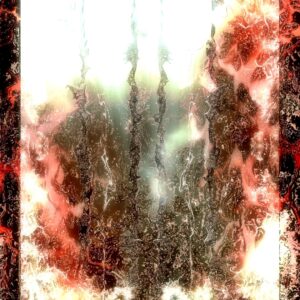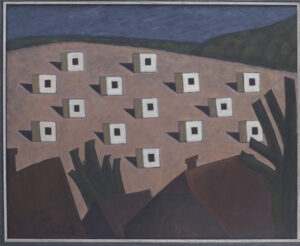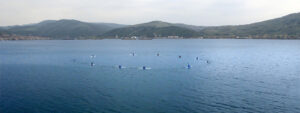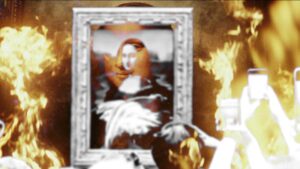Since the start of the Covid-19 pandemic, governments, companies, and institutions across the world have resurrected the ghost of technocratic optimism that dominated the twentieth century. From tele-work to tele-education and tele-health, governments, tech companies, and universities alike are currently espousing digital technologies as the cure for the virus [1]. Even though several communities around the world still have no access to adequate healthcare, education, or information, the fear of an unproductive society has led governments throughout the world to renew their enthusiasm over the power of electronic telecommunication. The initial dreams of a decentralized cyberspace, which emerged from technological experiments in the 1960s, have vanished into thin dust as big tech-companies claim increasing power over our social and economic lives online [2]. The privatized internet has turned telepathy—the ability to think, do, and sense at a distance—into the fundamental fuel of contemporary information capitalism. Given this scenario and considering the current socio-environmental crisis, we must ask ourselves if it is possible to practice telepathy outside of the oppressive market dynamics that dominate the internet today.
British artist Roy Ascott and Colombian artist Barbara Santos have both explored the possibilities of telepathy without the internet through their work with Amazonian amerindian communities—at different levels of depth and through radically different journeys, as I will further discuss. Ascott draws from ritualistic experiences with the Kuikuru in the Brazilian Amazon in order to imagine an expanded future of modern technoscience, acknowledging the power of ayahuasca as a networking technology in amazonian cultures [3]. Ascott sees in ayahuasca a biological and ancestral equivalent to western telematic technologies, which I argue is a misguided result of his short immersion into a complex amerindian philosophy. His approach reproduces exctractivist research methodologies that foreclose true horizontal dialogues between western and amerindian ontologies, and, perhaps most importantly, it remains supported in the exctractivist practices that sustain the modern technological industrial complex.
In contrast, Santos’ approach to her work with indigenous communities in the Amazon aims at creating open dialogues between western technoscience and ancestral technologies. Santos has been working for almost two decades with different knowers[4] from multiple ethnic groups in the Colombian Amazon, creating collaborative spaces where ancestral and digital technologies are brought together in experimental settings. Her projects develop regenerative networks of exchange that explore the healing practices at the core of ancestral technology, and which become all the more relevant in the face of the current socio-ecological destruction faced by the Amazon and Earth itself. Through a comparison between the creative methodologies and discourses of both Ascott and Santos, I propose it is vital that we reflect upon the difference between “extractive telepathy” and “regenerative telepathy” in order to find better ways of communicating between humans and non-humans with the damaged planet we inhabit.
Extractive Telepathy
Roy Ascott played a key role in the first telematic experiments in the arts towards the end of the 1970s and the beginning of the 1980s [5]. At that time, Ascott and other media artists envisioned the emergence of an electronic and decentralized participatory network that would have a deep spiritual impact in global culture, transforming planetary consciousness through love and interconnection. Through developing technological prototypes through artistic methodologies, Ascott’s work has always sought to push the boundaries of western knowledge through experimenting with multiple types of technologies, insisting on the spiritual potential of electronic technology [6]
Ascott’s spiritual approach to digital technologies becomes much clearer when he writes about the similarities between modern telematics and indigenous knowledge throughout the American continent (2003, p. 3; 2003c, p. 245; 2003d, p. 359). After his experience with ayahuasca in a visit to the Kuikuru in the Brazilian Amazon in 1997, Ascott drew parallels between cyberspace and the shamanic psychic space, suggesting that “Vegetal Reality and Virtual Reality will combine to create a new ontology, just as our notions of outer space and inner space will coalesce into another order of cosmography” (2000, p. 3). In his view, amerindian ancestral knowledges could catapult modern technoscience into a next level that he calls “the moist environment, located at the convergence of the digital, biological and spiritual” (p. 4). In other words, he envisioned that modern technology and amerindian knowledge would merge into one another in order to produce hybrid technologies. However, where these technologies would be produced and by whom remain as two of the many questions not explored by his texts.

Regenerative Telepathy
Barbara Santos was formed as an electronic artist in Bogotá, and her work has been deeply influenced by early experimentation with digital and audiovisual media in the 1990s. However, in 2005 Santos abandoned the traditional urban art scene in order to develop artistic collaborations with indigenous knowers at the Amazon, stepping away from the production of museum or festival pieces in order to explore open exchanges between multiple kinds of technological knowledge. In November 2016 Santos invited several people to create El Cuenco de Cera (The Bee Wax Gourd), a laboratory of art, science, and technology from the perspective of ancestral indigenous knowledge, which started with a series of exchanges at the Pirá-Paraná river in southeastern Colombia—also the north of the Amazon basin [9]. The project has brought together acoustic and visual artists, electric engineers, programmers, anthropologists, as well as indigenous knowers and their young apprentices, in order to explore the origins of ancestral and digital technologies through open dialogues and experimentation. These laboratories do not pretend to find the keys to unlock the complex knowledge systems of indigenous cultures—in part, because most people who come from the outside do not speak their languages and are not familiar with local practices—, but to create a space capable of holding bonds and morphing translations between different perspectives (Santos 2019, p. 77)
In her recent book Healing as Technology (2019) [10], Santos interviews multiple indigenous knowers and two renowned anthropologists who work in the Amazon, asking them about the origins of ancestral and digital technologies in order to plot an initial network of their connections and differences. The book begins to unpack the situated knowledge of indigenous telepathic practices, which enable Amazonian communities to connect to the ecological networks that sustain the balance of their territories, and to perform healing rituals that maintain this balance. Jesús León Muipu, from the Tatuyo ethnic group, describes the telepathic qualities of karayuru–a red powder made from leaves and minerals in the forest—that allow him to connect to the Amazon while being in large urban spaces (p. 32). Tarsicio Vanegas, from the Itana ethnic group, describes the bird feathers used in rituals as folders inside a computer, which allow him to access particular bits of knowledge (p. 56), and Libardo Bolívar Marín, from the Tatuyo ethnic group, also describes yagé—an equivalent to ayahuasca in the Colombian Amazon—as a technology that stores knowledge in the Maloka, the ancestral house. Vanegas, Bolívar Marín, and Stephen Hugh-Jones, a British anthropologist working in the Amazon since the 1960s, also refer to the Maloka as a computer that allows knowers to store and recombine information, to structure the flows of nature, and to navigate their material-spiritual territories (p. 59; p. 66; p. 79).
Indigenous knowers in the Amazon access the network of information in the forest through plants and minerals, which are activated by ancestral technologies in the form of oratory, songs, and rituals inherited from their spiritual ancestors. They are not the creators nor the owners of these technologies; they maintain and heal the bonds of an intelligent network that has been present since the beginning of time. In conversation with Juan Álvaro Echeverri, a Colombian anthropologist with decades of work in the Amazon, Santos unpacks the materiality of these ancestral technologies pointing to the electronic bonds that bind the molecular level of life and matter. Echeverri gives the example of quartz and gold, both sacred in amazonian communities because of their powerful ritualistic properties, and which are also fundamental elements in digital recording devices (p. 83). The electronic bonds that compose strong minerals at an atomic level function as a server’s bits that store information within plants, rocks, and other natural elements, which in turn are capable of activating memories and knowledge in the body when used in particular rituals (p. 82). Digital technologies channel the same electricity contained in minerals in order to retain and circulate information. Then, telematics is not created by the alchemy of western technoscientific inventions like digital computers; telematics has always been part of the Earth and it is contained by life and matter themselves. Telepathy is fundamentally material.

Even though Ascott understood electronic media as spiritual and material phenomena (2003b, p. 330), he focused primarily on the development of bio-electronic technologies without questioning the sources of the materials that create such technologies. Through a different approach, the knowers interviewed by Santos point towards the common spiritual and material origins of western and ancestral technologies without forgetting their fundamental differences. Davi Kopenawa, from the Yanomami ethnic group, says that minerals such as gold hold knowledge directly related to the spirit of the sun, which is tied to the source of life and the flow of energy through all that is living (Santos, p. 44). Material and spiritual are not separated categories in indigenous philosophy, as the spiritual characteristics of a given material are contained in its composition and relation to its environment. Technology, thus, emerges from and is contained by the will of spirits, which we could interpret to be, to some extent, the electronic make up of minerals themselves.
Even though there are points of connection between western and indigenous technologies, their differences are crucial. Kopenawa says that minerals must be kept under the soil because their extraction brings disease to the world (p. 45), a claim that stands in sharp contrast to the extractive practices at the core of modern technologies. As Libardo Bolívar Marín suggests, western technology misuses the spiritual force of technology in order to construct and destruct; indigenous knowers use it instead to heal and protect (p. 69). In the face of the ecological disaster caused by mining and the waste produced by capitalist technologies, and considering the arrival of a virus that has hijacked the survival of vulnerable communities around the world, it is vital to consider the material base of the technologies currently promoted as the socioeconomic cure to Covid-19. Santos’ long-term collaborative practice and deep engagement with Amazonian indigenous communities provides fresh alternatives to the study of the intersections between art, science, and technology, through carefully listening to amerindian ontologies that challenge the colonial anthropocentrism at the core of western technoscience[11].
Conclusion
Modern telematics has undoubtedly shifted the consciousness of those who are part of its global networks. However, as the internet increasingly becomes a consumer good capable of exploiting our most intimate desires and turn them into profit, it is paramount that we consider the origins of interconnected digital technologies and question the uses we give to them. Ascott’s dreams of a decentralized and loving telematic embrace were never fully realized, as digital telepathy became quickly subsumed by hypermodern capitalist modes of production and consumption. What he dreamed of in terms of education via teleconferencing as a way to expand global consciousness (2003a, p. 197), is now espoused by governments and tech-companies as the most profitable and easy solution to the Covid-19 pandemic. The “bird’s eye-view, the all-over, all-embracing, holistic systems view of structures, relationships, and events” (2003c, p. 236) that telematic works aspired to in the 1990s, has engendered the surveillance apparatus that embraces the entire world, not with love, but with chains made of fiber optics and conflict minerals.
Ascott’s intuition about other forms of networked telepathy in Amazonian indigenous cultures, which he called Vegetal Reality, has complicated echoes nowadays. Through placing his attention on shamanism, Ascott questioned the dryness of digital computers and started to think about the possibilities of bio-technologies. However, his approach has been mainly echoed by bio-art experiments with manufactured lab-life in controlled environments, not by the entangled, complex, interdependent, and context-aware knowledge of ecological dynamics. The interconnections Ascott imagined, at their core, are different from the rhizomatic ecological connection of life and matter in the planet—which predates any human historical formation—, and with which indigenous knowledge interfaces with. Western technoscience is heavily founded on colonial practices, since there is always a central matrix that benefits from a set of peripheral nodes of material extraction. In conversation with Santos, Jesús León Muipu tells us that digital technology comes as a reconquest, a second conquista of Amazonian territories (p. 32). His appreciation holds true both in the material level, due to mining and deforestation, and in the spiritual level, as languages and local technologies are replaced by digital devices without open experimentation and dialogue.
Ascott was trying to humanize western technoscience through emphasizing its spiritual connotations. However, that is precisely the very pitfall of his approach: we do not need to come up with spiritual ways of relating to our technologies, but to place spirituality at the center of what we think of as technology. In other words, does it matter if we develop loving and spiritual relations to our computers if they are still fueled by an exctractivist industry based on labor exploitation, deforestation, mining, and producing millions of tons of e-waste per year? Santos research suggests that instead of falling into binary traps between techno-optimism and techno-pessimism, it is crucial to explore the ways in which the online culture we participate in can be altered and better informed by the ecological paradigms of ancestral technologies. What amerindian technologies show us is that in order to reevaluate and reappropriate the role of digital technologies in our lives, it is important that we reflect on the material dimension of our telepathic systems.
Covid-19 is affecting the Amazon at a significantly higher rate than other regions in the world, killing several knowers along with their knowledge about how to relate to the network of ecological telepathy that sustains the balance of the forest. Under this scenario, it is vital that we situate ourselves within the extractive dynamics of digital technologies, and question the telepathic consequences that our actions have elsewhere. Nevertheless, my point is not to say that modern western life should be more like indigenous life, nor is it to promote cultural appropriations of amerindian knowledge into our ways of living. But it is crucial that we—the networked inhabitants of digitized urban life—listen carefully to other ways of relating to the Earth, and engage in respectful and horizontal dialogues with other forms of telepathic doing and thinking in order to construct new rituals of communion amongst ourselves, with other species, and with the material world around us. This might be the only way of altering the dangerous course that digital technologies have taken as apparatus for social control and unprecedented accumulation of resources. Considering the acute crisis that we face due to Covid-19, as well as the imminent socioecological catastrophe created by capitalist systems, it is vital that we reflect on more regenerative possibilities of doing, thinking, and sensing each other at a distance.
Notes
1. Naomi Klein, Google CEO Eric Schmidt pushing for more telehealth, remote learning, broadband. Screen New Deal. https://theintercept.com/2020/05/08/andrew-cuomo-eric-schmidt-coronavirus-tech-shock-doctrine/
2. In her most recent book “Surveillance Capitalism”, Shoshana Zuboff further discusses the overlap between digital technologies and capitalist markets, as private companies profit on our social and spatial relations connected to the internet.
3. Ayahuasca is a medicinal brew used by spiritual leaders and communities in several regions of the Amazon. Beyond its hallucinogenic properties, its relevance for amazonian communities lies in its function as a connector to multiple layers of life and reality.
4. In Spanish, it is common to refer to those who bear ancestral knowledge and wisdom as sabedores, which literally translates into “knowers”.
5. At Ars Electronica in 1982, Ascott used satellite technologies in order to perform a global simultaneous toss of the I Ching (Ascott 2003a), bringing multiple sites together through a techno-spiritual encounter. In 1989, also at Ars Electronica, Ascott presented “Aspects of Gaia: Digital Pathways across the Whole Earth” where participators from around the world used telematic networks in order to create and transform texts and images inspired in James Lovelock, a british chemist who referred to Gaia as the dynamic and interconnected flow of life energies that creates and sustains Planet Earth (Shanken 2003, p. 70).
6. Roy Ascott is referred to as a visionary in multiple texts compiled by Edward Shanken, a term that I find highly problematic due to its historical connotations related to religious messianism and progress.
7. In 2017, The Guardian reported on human rights abuses in mining practices in countries like Colombia, Myanmar, and Peru, are tied to the production of smartphones and TVs. https://www.theguardian.com/global-development/2017/apr/07/tech-companies-conflict-minerals-rights-abuses-verisk-maplecroft
8. In an article for The New York Times, Kara Swisher discusses the increasing consumption of hallucinogenics such as LSD or ayahuasca in Silicon Valley, as a source for inspiration in the start-up world. https://www.nytimes.com/2018/08/23/opinion/elon-musk-burning-man-drugs-lsd.html
9. To know more about El Cuenco de Cera, please visit their website https://quiasma.co/badi-kati-narise-tuayire
10. The book is currently not available in English, but a free PDF version in Spanish can be downloaded in the following link: https://idartesencasa.gov.co/arte-ciencia-y-tecnologia/libros/curacion-como-tecnologia-basado-en-entrevistas-sabedores-de-la
11. Santos’ approach resembles the recent ontological turn in Anthropology characterized by scholars such as Eduardo Viveiros de Castro, Eduardo Kohn, and Philippe Descola, who perform a decolonial deep listening of Amazonian knowledge as profound philosophical traditions with their own theoretical propositions, not as pre modern sensibilities or as symbolic equivalents to western modern thought (Viveiros de Castro 2014, p.48).
–
Bibliography
Ascott, R. (2000). Edge-Life: Technoetic structures and moist media. In Art, Technology, Consciousness: Mind@large. Intellect Books.
Ascott, R. (2003a). Art and Telematics: Towards a Network Consciousness (1984). In E. A. Shanken (Ed.), Telematic Embrace: Visionary Theories of Art, Technology, and Consciousness (pp. 232–246). University of California Press.
Ascott, R. (2003b). Back to Nature II: Art and Technology in the Twenty-First Century (1995). In E. A. Shanken (Ed.), Telematic Embrace: Visionary Theories of Art, Technology, and Consciousness (pp. 327–339). University of California Press.
Ascott, R. (2003c). Is There Love in the Telematic Embrace? (1990). In E. A. Shanken (Ed.), Telematic Embrace: Visionary Theories of Art, Technology, and Consciousness (pp. 232–246). University of California Press.
Ascott, R. (2003d). Weaving the Shamantic Web: Art and Technoetics in the Bio-Telematic Domain (1998). In E. A. Shanken (Ed.), Telematic Embrace: Visionary Theories of Art, Technology, and Consciousness (pp. 356–362). University of California Press.
Santos, B. (2019). Curación como Tecnología: Basado en Entrevistas a Sabedores de la Amazonía [Healing as Technology: Based on Interviews with Knowers from the Amazon]. Idartes.
Shanken, E. A. (2003). From Cybernetics to Telematics: The Art, Pedagogy, and Theory of Roy Ascott. In E. A. Shanken (Ed.), Telematic Embrace: Visionary Theories of Art, Technology, and Consciousness (pp. 1–96). University of California Press.
Viveiros de Castro, E. (2014). Cannibal Metaphysics: For a Post-Structural Anthropology (2009) (P. Skafish, Trans.). Univocal.
Zuboff, S. (2019). The Age of Surveillance Capitalism: The Fight for a Human Future at the New Frontier of Power. Profile Books.
About the author
Juan Pablo Pacheco Bejarano (Bogotá, 1991) is a visual artist and writer whose research investigates the historical, material, and poetic intersections between technology and the biosphere. Through texts, videos, and web projects, his work dives more specifically into the decolonial options that emerge from the deep relations between water, the internet, and telepathy. Juan Pablo has also produced transdisciplinary and collaborative laboratories, which seek to promote the critical appropriation of and experimentation with various digital and analogue technologies.
Cite as
Juan Pablo Pacheco Bejarano. “Telepathy without the internet,” JVC Magazine, 27 August 2020, https://www.journalofvisualculture.org/telepathy-without-the-internet/





